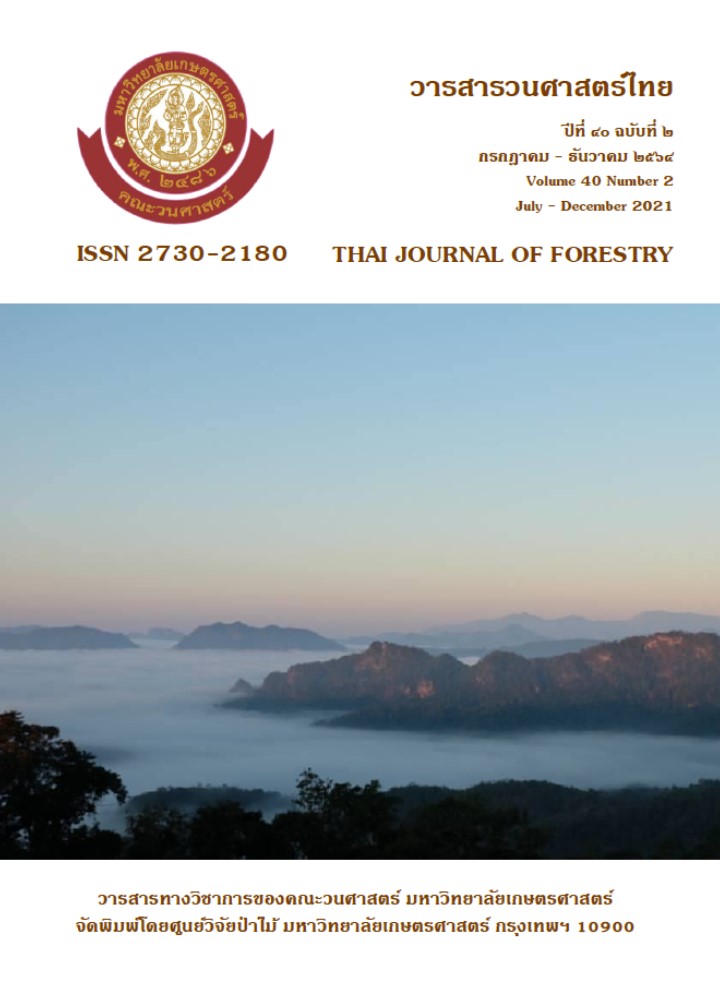การประยุกต์แบบจำลอง CLUE-S และแบบจำลอง SWAT ในการคาดการณ์การใช้ประโยชน์ที่ดิน และปริมาณน้ำท่าในพื้นที่ลุ่มน้ำย่อยแควน้อยตอนบน อำเภอนครไทย จังหวัดพิษณุโลก
Main Article Content
บทคัดย่อ
การประยุกต์แบบจำลอง CLUE-S และแบบจำลอง SWAT ในการคาดการณ์การใช้ประโยชน์ที่ดิน และปริมาณน้ำท่าในพื้นที่ลุ่มน้ำย่อยแควน้อยตอนบน มีวัตถุประสงค์เพื่อศึกษา คาดการณ์การใช้ประโยชน์ที่ดิน และประมาณค่าปริมาณน้ำท่า จากการเปลี่ยนแปลงการใช้ประโยชน์ที่ดินในอนาคตปี พ.ศ. 2556, พ.ศ. 2561 และปี พ.ศ. 2566 โดยใช้แบบจำลอง CLUE-S และแบบจำลอง SWAT
ผลการศึกษา พบว่า การคาดการณ์การใช้ที่ดินในปี พ.ศ. 2566 ส่วนใหญ่มีแนวโน้มเพิ่มขึ้นจากปี พ.ศ. 2561 ได้แก่ พื้นที่เกษตรกรรม พื้นที่แหล่งน้ำ และพื้นที่ชุมชนและสิ่งปลูกสร้าง ร้อยละ 42.16, 6.44 และ 1.39 ตามลำดับ ในขณะที่พื้นที่ป่าไม้ และพื้นที่เบ็ดเตล็ด มีเนื้อที่ลดลง ร้อยละ 45.16 และ 4.83 การประยุกต์แบบจำลอง SWAT ในการประมาณค่าปริมาณน้ำท่าพบว่า แบบจำลอง SWAT มีประสิทธิภาพระดับดี โดยใช้ข้อมูลการตรวจวัดปริมาณน้ำท่าสถานี N.36 ในการปรับแก้ค่าความคลาดเคลื่อน และสอบเทียบค่าความถูกต้องในช่วงปี พ.ศ. 2543 ถึง พ.ศ. 2561 โดยพิจารณาจากค่าสถิติ R2, NSE และ PBIAS มีค่า 0.80, 0.74 และ 27.10 ตามลำดับ การคาดการณ์ปริมาณน้ำท่าปี พ.ศ. 2566 มีปริมาณน้ำท่าสูงกว่าปี พ.ศ. 2561 ร้อยละ 12.06 ส่วนการศึกษาลักษณะทางอุทกวิทยาบางประการในปี พ.ศ. 2556, 2561 และ พ.ศ. 2566 โดยใช้ร้อยละของปริมาณน้ำท่าต่อปริมาณน้ำฝนพบว่า
มีค่าสูงสุดในปี พ.ศ. 2556 รองลงมาคือปี พ.ศ. 2566 และ พ.ศ. 2561 โดยมีค่าร้อยละ 14.87, 13.59 และ 12.17 ตามลำดับ ซึ่งจากการศึกษาพบว่า การเปลี่ยนแปลงการใช้ประโยชน์ที่ดิน โดยการเพิ่มขึ้นของพื้นที่เกษตรกรรม พื้นที่ชุมชนและสิ่งปลูกสร้าง และพื้นที่แหล่งน้ำ ส่งผลกระทบต่อการเปลี่ยนแปลงปริมาณน้ำท่าในพื้นที่ลุ่มน้ำย่อยแควน้อยตอนบนเพิ่มสูงขึ้นเล็กน้อย
Downloads
Article Details

อนุญาตภายใต้เงื่อนไข Creative Commons Attribution-NonCommercial-NoDerivatives 4.0 International License.
ข้าพเจ้าและผู้เขียนร่วม (ถ้ามี) ขอรับรองว่า ต้นฉบับที่เสนอมานี้ยังไม่เคยได้รับการตีพิมพ์และไม่ได้อยู่ในระหว่างกระบวนการพิจารณาตีพิมพ์ลงในวารสารหรือสิ่งตีพิมพ์อื่นใด ข้าพเจ้าและผู้เขียนร่วม (ถ้ามี) ยอมรับหลักเกณฑ์และเงื่อนไขการพิจารณาต้นฉบับ ทั้งยินยอมให้กองบรรณาธิการมีสิทธิ์พิจารณาและตรวจแก้ต้นฉบับได้ตามที่เห็นสมควร พร้อมนี้ขอมอบลิขสิทธิ์ผลงานที่ได้รับการตีพิมพ์ให้แก่วารสารวนศาสตร์ คณะวนศาสตร์ มหาวิทยาลัยเกษตรศาสตร์ กรณีมีการฟ้องร้องเรื่องการละเมิดลิขสิทธิ์เกี่ยวกับภาพ กราฟ ข้อความส่วนใดส่วนหนึ่ง หรือ ข้อคิดเห็นที่ปรากฏในผลงาน ให้เป็นความรับผิดชอบของข้าพเจ้าและผู้เขียนร่วม (ถ้ามี) แต่เพียงฝ่ายเดียว และหากข้าพเจ้าและผู้เขียนร่วม (ถ้ามี) ประสงค์ถอนบทความในระหว่างกระบวนการพิจารณาของทางวารสาร ข้าพเจ้าและผู้เขียนร่วม (ถ้ามี) ยินดีรับผิดชอบค่าใช้จ่ายทั้งหมดที่เกิดขึ้นในกระบวนการพิจารณาบทความนั้น”
เอกสารอ้างอิง
Abbaspour K.C., E. Rouholahnejada, S. Vaghefia, R. Srinivasanb, H. Yanga and B. Kløve. 2015. A Continental - scale hydrology and water quality model for Europe: calibration and uncertainty of a high-resolution large-scale SWAT model. J. Hydrol. 524: 733-752.
Institute of Water and Agricultural Resources Information (Public Organization). 2012. Data Collection and Analysis Data Project of 25 Basin and Flood Drought Model, Nan River Basins. Ministry of Natural Resources and Environment, Bangkok. (in Thai)
Kiriwongwattana, K. 2007. Application of Clue-s Model for Land Use and Land Cover Changes Projection at Mae Yod Watershed, Maechaem District, Ching Mai Province. M.S. Thesis , Kasetsart University. (in Thai)
Khotapun, C. 2012. Application of Clue-s Model for Predicting Land Use Changes in Si Sa Ket Province Between A.D. 2010-2017. Kasetsart University. (in Thai)
Meteorological Department. 2018. Meteorology Available source: https://www.tmd.go.th/info/info.php?FileID=23, February 20, 2021. (in Thai)
Moriasi, D.N., J.G. Arnold, M.W.V. Liew, R.L. Bingner, R.D. Harmel and T.L. Veith. 2007. Model evalation guideline for systematic quantification of accuracy in watershed simulation. Transaction of the ASABE 50(3): 885-900.
Neitsch, S.L., J.G. Arnold, J.R. kiniry and J.R. Williams. 2009. Soil and Water Assessment Tool Theoretical Documentation (Version 2009). Available source: https://swat.tamu.edu/media/99192/swat2009-theory.pdf, February 20, 2021.
Tangtham, N. and S. Yuwananont. 1996. Impact of land use change on streamflow and flow characteristics of Pasak basin. Thai J. For. 15(2): 98-110.
Versuri, O. 2005. The Impacts of Land Use Changes on Runoff in the Upper Nan Basin Using SWAT Hydrologic Model. M.S. Thesis, Chulalongkorn University. (in Thai)
Witthawatchutikul, P., S. Pan-uthai and B. Deesaeng. 2011. Forested watershed runoff model. Thailand Forest Ecological Research Network (T-FERN): Research Result Relationship. January 26-27, 2011. Thailand, Bangkok.
Wongsakhiri, S. 2011. Water Quantity and Quality Assessment for Lower Pong Basin by SWAT Model. M.S. Thesis, Khon Kaen University. (in Thai)
Wuttichatkitcharoen, P. 2016. Study of runoff simulation in Huai Luang watershed using SWAT. CRMA Journal 14: 145-158. (in Thai)


